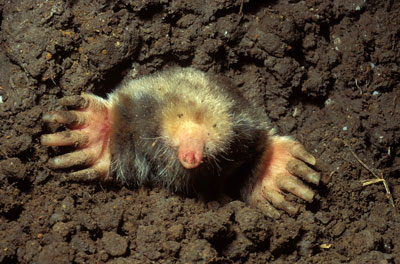
By Dan Zarlenga, Missouri Department of Conservation
Photo caption: The eastern mole, a face only an aerated patch of soil could love.
Photo by Jim Rathert, Missouri Department of Conservation
Let’s face it, moles aren’t exactly popular with many homeowners. They have a reputation for defacing lawns with their below ground tunneling, making it more difficult to mow or walk. Gardeners blame them for chewing on and uprooting their plants. Even the name itself conjures up the idea of an unwanted interloper.
But like so many other things in nature, our negative feelings about moles are based on how they inconvenience our attempts to shape and remake the landscape to fit our desires. Once we dig a little deeper to discover the “hole” story, we might find that in nature’s scheme of things, moles aren’t so bad.
True, one might have to be pretty creative to find physical beauty in moles. The eastern mole is a chipmunk-size creature that has a featureless head, except for a flexible, piglike snout. Its tail is almost naked. A mole’s eyes aren’t much to look at, or through, being able to detect nothing more than basic patterns of light and dark. But this suits their underground existence just fine.
What moles are extremely good at detecting though, is smell. They also excel at gathering input through sound and touch. Their velvety fur is usually slate gray but can look silvery. This slick coat helps them easily shed dirt and soil as they travel through it.
Moles breed in late winter or spring and litters of two-to-five young are born in March, April, or May. After only about four weeks of rapid development, the young are off on their own to fend for themselves. Beyond doing what they must do to reproduce, moles live very solitary lives.
The mole uses its extra-large front feet to move through the soil the same way we might swim underwater. If you think swimming in water burns calories, try swimming through dirt! It’s likely why a mole needs to consume about half its body weight in food each day.
Contrary to some beliefs, moles do not dine on your plants. But many of the critters that moles eat, do eat your plants. Moles feed on soil-dwelling invertebrates like grubs, beetles, spiders, centipedes, ant pupae, and cutworms. They even munch on larvae of invasive Japanese beetles! By helping control insect pests, moles are the friends of our farmers.
And true to the cycle of life, moles are essential food for other animals, such as snakes, hawks, owls, skunks, coyotes, and foxes.
So, what about all those annoying tunnels? Well, digging up the facts on moles reveals that they play a vital role in aerating our soils. Their subterranean activities loosen and mix the earth, allowing air and rainwater to penetrate so the plants and trees we love can use it. It’s an important task. And they do this all without the invoice of a lawn service company!
The bottom line is that moles help keep yard, garden, and farm pests in check, and make our soils healthier. So why not at least consider tolerating them? Maybe once you learn their “hole” story, you might just “dig” moles a little more.


